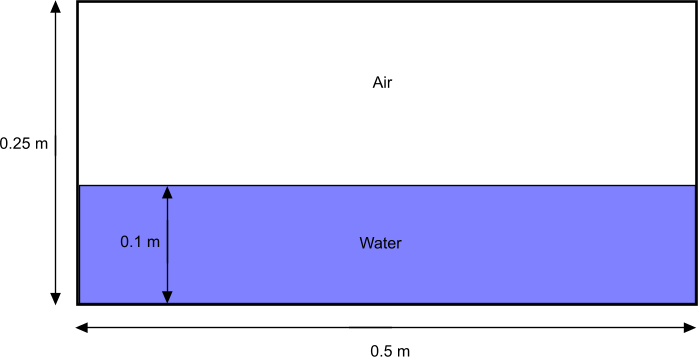VOF: Tank Sloshing with Adaptive Meshing
To reduce the computational time and resources required for VOF multiphase simulations, Simcenter STAR-CCM+ provides both Adaptive Mesh Refinement (AMR) and Adaptive Time-Stepping. AMR provides adaptation in space and Adaptive Time-Stepping provides adaptation in time. Together, these models improve the resolution of the interface with minimum computational effort by adjusting the mesh and the time-step during the simulation. Additionally, Simcenter STAR-CCM+ offers the Implicit Multi-stepping VOF solver which can be used to decrease computational costs further by sub-stepping the volume fraction transport equation to obtain a sharp interface while allowing for a larger flow time-step.
This tutorial demonstrates the workflow for setting up a simulation for water sloshing inside a container with 0.5 m (length) x 0.02 m (width) x 0.25 m (height) dimensions. The water is initially at rest in the lower part of the container, as shown below:

The container is subject to an unsteady acceleration in the horizontal direction that causes the water to slosh from side to side inside the container. The Volume of Fluid (VOF) Multiphase model is used to model the bulk movement of the water and to track the water-air interface. As the water sloshes inside the container, the water-air interface moves and develops small-scale flow features such as droplets and bubbles.
Adaptive Mesh Refinement (AMR) is a dynamic remeshing method that refines or coarsens cells in the volume mesh based on adaptive mesh criteria. Solution quantities are automatically interpolated to the adapted mesh. This tutorial uses AMR to identify the cells near the interface and refine the mesh accordingly. As the interface develops and moves during the simulation, AMR continually regenerates the mesh to ensure that the interface is resolved and tracked efficiently. Adaptive Mesh Refinement gives you the resolution of a fine mesh but at reduced computing cost: the mesh is refined only where you need it, in the volume close to the interface.
The VOF Multiphase model uses the High-Resolution Interface Capturing (HRIC) convection scheme to maintain a sharp interface. The HRIC scheme is bound by an upper Courant number (CFL) limit. If this CFL limit is exceeded locally, the method falls back to the upwind scheme to maintain stability. As a first-order method, the upwind scheme results in an irreversibly smeared interface.
In many cases, the limiting factor of the global time-step is the time scale of the VOF transport dictated by the HRIC CFL limit. Applying implicit multi-stepping to the volume fraction transport equation allows to reduce the effective CFL number by specifying a number of sub-steps. In doing so, the global flow time-step can be enlarged by the same factor provided that the remaining physics is still reasonably resolved at the larger time-step. This is especially true if the coupling between volume fraction and momentum transport is weak, or if the flow field's time scale is significantly larger than that of the volume fraction transport.
When you activate multi-stepping, the Segregated VOF solver performs multiple steps per time-step. For a given time-step size, multi-step calculations take longer to run than single-step calculations. However, multi-step simulations can use a larger time-step, so the overall calculation time can be reduced while still maintaining the sharp interface.
In this tutorial, as the cell size changes with AMR, manually specifying the time-step is difficult. Hence, you are advised to use Adaptive Time-Stepping in conjunction with AMR. The Adaptive Time-Step model lets you specify a suitable time-step provider which adjusts the time-step automatically as the simulation proceeds. In this simulation, you use the Free Surface Implicit Multi-Step time-step provider which controls the time-step size such that the CFL condition for implicit multi-stepping is achieved for all cells in the vicinity of the interface.